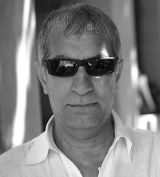- Forum
- General Discussion | Introductions | Off Topic Forum
- Photography News
- Hints of Canon mirrorless to come ?
Hints of Canon mirrorless to come ?
-
 Topic Author
Topic Author
- Baydream
- Moderator
-
- Canoni/60D/70D/5DmkIII
- Followers: 388
- Posts: 11185
-
Points:
7278
Post #202589
Shoot, learn and share. It will make you a better photographer.
fineartamerica.com/profiles/john-g-schickler.html?tab=artwork
-

- KCook
- Photo Elder
-
- Canon EOS 50D and Olympus E-P5
- Followers: 1325
- Posts: 5410
-
Points:
32913
Post #202646
The EF mount is HUGE. It's was overdesigned for a full frame 35mm negative. Using EF lenses with a smaller sensor seems like kind of a waste. The EF mount was designed to accomodate a big mirror flipping up out of the way. If you go mirrorless you can design your lenses so they sit much closer to the sensor. But not EF mount lenses -- 'cause they are designed to sit a certain distance from the sensor.
Basically an EF mount mirrorless system is not going to be much smaller than a digital rebel. The only place you are going to save space is by getting rid of the pentaprism. You are just giving up the optical viewfinder. (Something many mirrorless system critics complain about.) And the advantages of phase detection autofocus vs contrast detection autofocus.
Really, if you want a Canon mirrorless system, put your Canon DSLR in "live view" mode and you are there.
If you want a smaller mirrorless camera you need to abandon the EF mount. Which means Canon has to come out with a whole new line of lenses, and there is no advantage to Canon vs any other mirrorless manufacturer.
If EF lenses are so great for mirrorless cameras, why doesn't Canon sell an adapter so their expensive lenses can be used on Sony/Olympus/Panasonic mirrorless cameras? Surely they all have 100% electronic interfaces?
-Matt
-

- Stealthy Ninja
- Moderator
-
- Fuji X stuff and a 1DsIII for some reason
- Followers: 982
- Posts: 16300
-
Points:
6837
Post #202690
mattmoran wrote: If you want a smaller mirrorless camera you need to abandon the EF mount. Which means Canon has to come out with a whole new line of lenses, and there is no advantage to Canon vs any other mirrorless manufacturer.
EF-S
-

- scifitographer
- Lone Wolf
-
- Canon 5D Mk II
- Followers: 9
- Posts: 176
-
Points:
0
Post #202693
I'd rather see a small lightweight canon with it's own line of small fast prime lenses with an optional EF adapter for those who insist on using EF lenses.
-

- Colourful Photography
- Has the Hang of it
- Canon
- Followers: 4
- Posts: 65
-
Points:
0
Post #202745
I'm colour blind, but it doesn't keep me from exploring the wonderfully colourful world around us.
Post #202755
Stealthy Ninja wrote: EF-S
The flange focal distance for EF-S is 44mm, just like for EF. By comparison, the flange focal distance for micro 4/3 is 20mm and for Sony E-mount is 18mm.
If Canon makes a mirrorless system that is compatible with EF and EF-S lenses, it will not be a small camera body. They wiill give up the big advantage of mirrorless to maintain compatibility with lenses designed to leave room for a mirror.
-Matt
-

- Stealthy Ninja
- Moderator
-
- Fuji X stuff and a 1DsIII for some reason
- Followers: 982
- Posts: 16300
-
Points:
6837
Post #202758
mattmoran wrote:
Stealthy Ninja wrote: EF-S
The flange focal distance for EF-S is 44mm, just like for EF. By comparison, the flange focal distance for micro 4/3 is 20mm and for Sony E-mount is 18mm.
If Canon makes a mirrorless system that is compatible with EF and EF-S lenses, it will not be a small camera body. They wiill give up the big advantage of mirrorless to maintain compatibility with lenses designed to leave room for a mirror.
Could make it like the NEX cameras.
-

- KCook
- Photo Elder
-
- Canon EOS 50D and Olympus E-P5
- Followers: 1325
- Posts: 5410
-
Points:
32913
Post #202769
Kelly
-

- Stealthy Ninja
- Moderator
-
- Fuji X stuff and a 1DsIII for some reason
- Followers: 982
- Posts: 16300
-
Points:
6837
Post #202778
KCook wrote: Gotta agree with -Matt. A mirrorless design lugging EF-S lenses makes little sense. Though I do hope that the new mount can take a fully functional EF-S adapter. It would be super cool if Canon just adopted Sony's E-mount, but you-know-where would freeze over first.
Kelly
Lenses on the NEX system are pretty big too.
-

- Henry Peach
- Apprentice
-
- I currently use a 5DII or Sony Nex-3 most of the time.
- Followers: 50
- Posts: 2925
-
Points:
16
Post #202850
The biggest NEX lens I own (the standard zoom) is about the size of the smallest EOS lens I own (50mm f/1.4). The NEX zoom is about 1cm longer, although it's about that much thinner too. I bought a NEX to Nikon adapter, and I'm using old manual focus lenses on it. The adapter + lens is about the same size as the NEX standard zoom. But once again I'm back to wondering why a small, mf 50mm f/1.4 lens for 35mm film can be half the size of the same for my 35mm DSLR. Is it the AF? I would gladly give up AF for smaller size, although I suppose a lot of folks wouldn't want to do that. I've seen a few old, manual focus, cine lenses adapted for the NEX that are very small. Quality seems to be an issue, but I wonder what could be done if the lens was designed for the NEX from the get go.
Having carried the NEX for half a year now I am not as concerned with lens size. In use it's still significantly smaller than a DSLR. I don't want to go any bigger than the lenses I own now, but the NEX with a lens still takes up less space than a DSLR body alone. It's not a pants pocket camera, but it fits in a jacket pocket just fine. For the pants pocket camera I just assume I'll have to give up interchangeable lenses. How about an APS-C format digital camera the size of a Olympus Stylus Epic . For a truly pocket-able camera that had acceptable high ISO quality I can give up the zoom lens.
For me it is very important that the small camera I'm carrying works good at high ISOs. I'm most likely going to be shooting it in dim, interior situations, and I'm going to skip the flash, because on-compact-camera flash sucks even worse than on-DSLR flash. I don't care what Ashton Kutcher claims about that new Nikon, or the folks who like micro 4/3 say, looking at real world sample images they just don't even come close to an APS-C format sensor at ISO 1600 and 3200. At least for now. But if they figure out how to make a tiny sensor with decent high ISO I'd probably be content with a cell phone cam as my always carry pocket cam.
-

- Henry Peach
- Apprentice
-
- I currently use a 5DII or Sony Nex-3 most of the time.
- Followers: 50
- Posts: 2925
-
Points:
16
Post #202852
Colourful Photography wrote: So what's this? A camera that lets you take photos of mirrors?
A non-reflex design. Sure they've been around since day one, and the majority of film cameras were mirrorless without having to point it out, but the kids these days (mainly the ones working in the sale dept.) like to come up with new terms for old ideas.
-
 Topic Author
Topic Author
- Baydream
- Moderator
-
- Canoni/60D/70D/5DmkIII
- Followers: 388
- Posts: 11185
-
Points:
7278
Post #202864
Colourful, you made the same type of statement about "Pancake lenses".Henry Peach wrote:
Colourful Photography wrote: So what's this? A camera that lets you take photos of mirrors?
A non-reflex design. Sure they've been around since day one, and the majority of film cameras were mirrorless without having to point it out, but the kids these days (mainly the ones working in the sale dept.) like to come up with new terms for old ideas.
Yes, the "majority" of film cameras were "mirrorless" but those were early models that did not jet you see what the camera "saw". Based on that logic, more film cameras were fixed focal length, fixed aperture point-and-shoots, or as our friend calls them, PhD models (Push Here Dummy). Calling them "new terms for old ideas" is like calling not very accurate. Comparing a mirrorless camera to a Brownie or Rangefinder is totally off mark. These add the benefit of an SLR without the weight.
Shoot, learn and share. It will make you a better photographer.
fineartamerica.com/profiles/john-g-schickler.html?tab=artwork
-

- KCook
- Photo Elder
-
- Canon EOS 50D and Olympus E-P5
- Followers: 1325
- Posts: 5410
-
Points:
32913
Post #202963
Yup. AF (especially with motor in lens) and in lens IS both add bulk. I don't want to give up either, Canon has already spoiled me on that matter. Could give up these features for a viewcamera or medium format that will always live on a tripod. But not a handheld camera.But once again I'm back to wondering why a small, mf 50mm f/1.4 lens for 35mm film can be half the size of the same for my 35mm DSLR. Is it the AF?
Kelly
Post #203002
Rangefinders use mirrors but not that flip up like an SLR, which makes them more streamlined. There's one image that you see thru the viewfinder and an image that comes in to the film/sensor - the split image focus basically converges the two images I believe. The twin lens cameras have one lens that projects the image to the film and another that uses a mirror to reflect the image up so you hold the camera at waist level and look down at the image.
So besides the fact that there are older cameras with and without mirrors, I wonder if Canon intends to make mirrorless cameras compatible with EF lenses as well as with their newer lenses so people can use the bodies and lenses interchangeably.
Sharon
- Forum
- General Discussion | Introductions | Off Topic Forum
- Photography News
- Hints of Canon mirrorless to come ?
Latest Reviews
The Fujifilm XT5 is a 40MP mirrorless camera capable of 6.2K video at 30p. With those specs, it’s an ideal choice for photographers needing a camera to pull double duty for imaging and video.
The Canon EOS R100 is an entry-level mirrorless camera introduced in 2023. But just because it’s an entry-level camera doesn’t mean it’s a bare-bones camera. Find out why in this review!
Nikon’s retro-looking Nikon Zfc is anything but retro. Under its classic body is a host of features and amenities that make it a worthwhile compact mirrorless camera for 2024.
The Canon EOS R50 is one of the newest R-system cameras from Canon. Is it worth your money? Find out all the details you need to know in this comprehensive review.
Latest Articles
The Fujifilm XT5 is a 40MP mirrorless camera capable of 6.2K video at 30p. With those specs, it’s an ideal choice for photographers needing a camera to pull double duty for imaging and video.
Using leading lines in photography helps improve the composition by drawing viewers in and leading their eye from the foreground to the background. Explore some fine examples of this in this guide!
The Insta360 has one of the best lineups of action cams and 360-degree cameras. With these Insta360 accessories, you can elevate your photography and videography game!
Creating impactful photos of landscapes depends on many factors, not the least of which is your talent behind the lens. This guide explores other elements required for the best product.
The Canon EOS R100 is an entry-level mirrorless camera introduced in 2023. But just because it’s an entry-level camera doesn’t mean it’s a bare-bones camera. Find out why in this review!
Are you ready to upgrade your camera? Before buying new, you might consider the value of purchasing used gear to save money.
The Olympus OM-D E-M10 Mark IV is a micro four thirds camera released in 2020. It’s an entry-level system along with the OM-D E-M5 Mark III. Use this guide to determine which one is best for you!
Blue hour photography might not be as well known as golden hour photography, but it is every bit as good a time to create epic images of landscapes. Learn how in this quick tutorial!

















